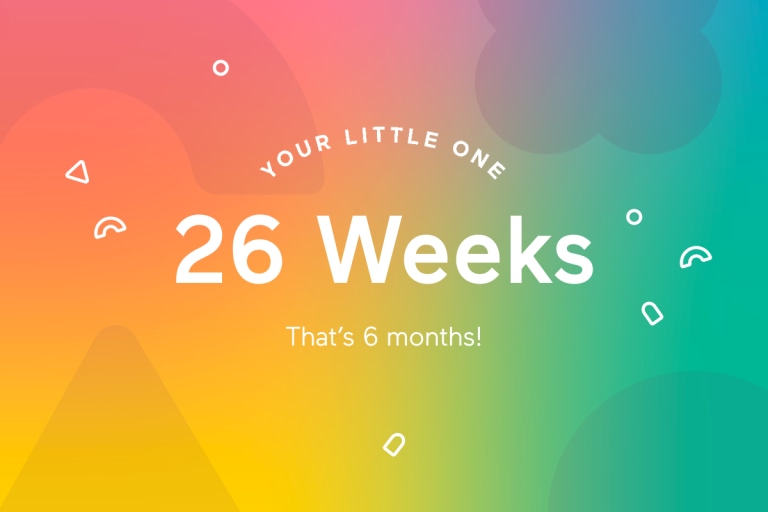Your 26-Week-Old Baby
Happy half birthday, baby! Plus, baby sign language, the next well-baby exam and really fun toys.
Doctor’s Corner: 6-Month Well Baby Visit
Can you believe it? You’ve made it halfway through baby’s first year. The newborn fog has lifted (hello again, world!), and you’re becoming a pro at doing everything one-handed, with a kiddo on your hip.
By now, you’ve been to a bunch of well-baby checkups. At the six-monther, your baby will have their weight, height and head circumference measured (per usual) to keep tabs on their growth. The pediatrician will do an exam from head-to-toe to check reflexes, heart, lungs, eyes, ears, belly, body movements and the diaper area.
You baby’s doc will also take a close look at developmental milestones like rolling, sitting, eating solid foods and teething, as well as emerging language and social skills. You may have questions about introducing new foods, allergies, breastmilk or formula intake, nap schedules and unusual poop (because Googling that was not a good idea). Be sure to write them down ahead of time, so you’ll remember in the moment.
This appointment includes a round of vaccines (you can check out the CDC’s immunization schedule to mentally prepare!). And with that in mind, try to schedule the well-baby visit in between nap times, so you won’t have an extra cranky baby on your hands.
Your Body: Finding Time to Exercise
Finding the time and energy to work out is challenging. There’s always a reason not to: you’re tired, you don’t have time, you don’t have childcare, you’d rather watch something on Netflix, laundry (SO.MUCH.LAUNDRY.), you’re really tired (yes, exhaustion deserves to be listed twice).
All of those reasons are completely valid and can be hard to power through. The key to getting back on track is to start small and do something that fits into your schedule (or lack thereof!). Here are a few tips to make exercising more manageable:
- Don’t go overboard. No need to go from 0 to 60. Start slow and build up the strength for more intense, longer workouts—your recovering body will thank you! Power walk for a few weeks before jogging or try low-intensity classes before jumping into HIIT workouts.
- Plan your workouts ahead of time. Head into a new week with a flexible gameplan. Let’s say your goal is to exercise three times this week. Plan on a weekend class outside of the house when your partner, family member or friend can be home with the baby, a long walk (or something like a Fit4Mom Stroller Strides total body class) with your kiddo during the week one day and an online workout during a naptime. If you’re eager to get out of the house, see if your local gym offers on-site childcare.
- Do something you like. Spinning, yoga, barre, pilates, kickboxing, cardio, Zumba, jogging, power walking, hip-hop dance, high-intensity interval training…when you enjoy your workout, you’ll be more motivated to stick with it. Going with a friend is even better!
- Do an online workout. At this unpredictable stage of life, it’s often easiest to fit in a workout at home. No commutes, no set class times, no need to book childcare. There’re so many awesome online workouts that can be done in your living room, with minimal or zero equipment. A few tested and approved recs from new moms include: YogaGlo, Beachbody on Demand, Yoga with Adriene, Class FitSugar, Boho Beautiful, the Fitness Marshall, and ClassPass Live.
- Workout at work. Take advantage of your office’s onsite gym or zip out for a nearby workout or walk during lunch if your schedule allows. It’s not always easy when you’re eager to just get home to your baby at the end of the day, but it’s an important mental and physical boost.
- Chunk it out. Rather than aiming for a long workout (which doesn’t always work!), do a few things in spurts throughout the day—a short Pilates video online, an impromptu ab session next to your baby on the playmat and a burst of cardio with a neighborhood walk.
Exercising with a baby at home isn’t always going to go as planned. A doorbell or dog bark may interrupt your little one’s nap (and your workout in turn). Just remember: whatever you do for you (even if it’s just 10 minutes!) is a victory these days!
Baby Sign Language
Babies know what they want well before they can actually say the words out loud. Luckily, there’s an effective way to communicate wants and needs with simple hand gestures: baby sign language. Even at six months old, you can start teaching your kiddo a handful of essential signs to help them express themselves with a lot less frustration.
Start with signs that signal common objects, activities or people (more, milk, mommy, daddy, diaper, all done, sleep). (This book can be a good starting place.) Engage in the activity and say the word while making the sign. They may not sign back until they’re closer to seven or eight months, so be patient throughout the process.
With enough repetition over time, your baby will catch on and start replicating those signs. Be sure to keep talking to your baby in addition to signing to encourage verbal language development too.
Babylist Staff
Editor
Babylist editors and writers are parents themselves and have years of experience writing and researching, coming from media outlets like Motherly, the SF Chronicle, the New York Times and the Daily Beast, and the fields of early childhood education and publishing. We research and test hundreds of products, survey real Babylist parents and consult reviews in order to recommend the best products and gear for your growing family.

